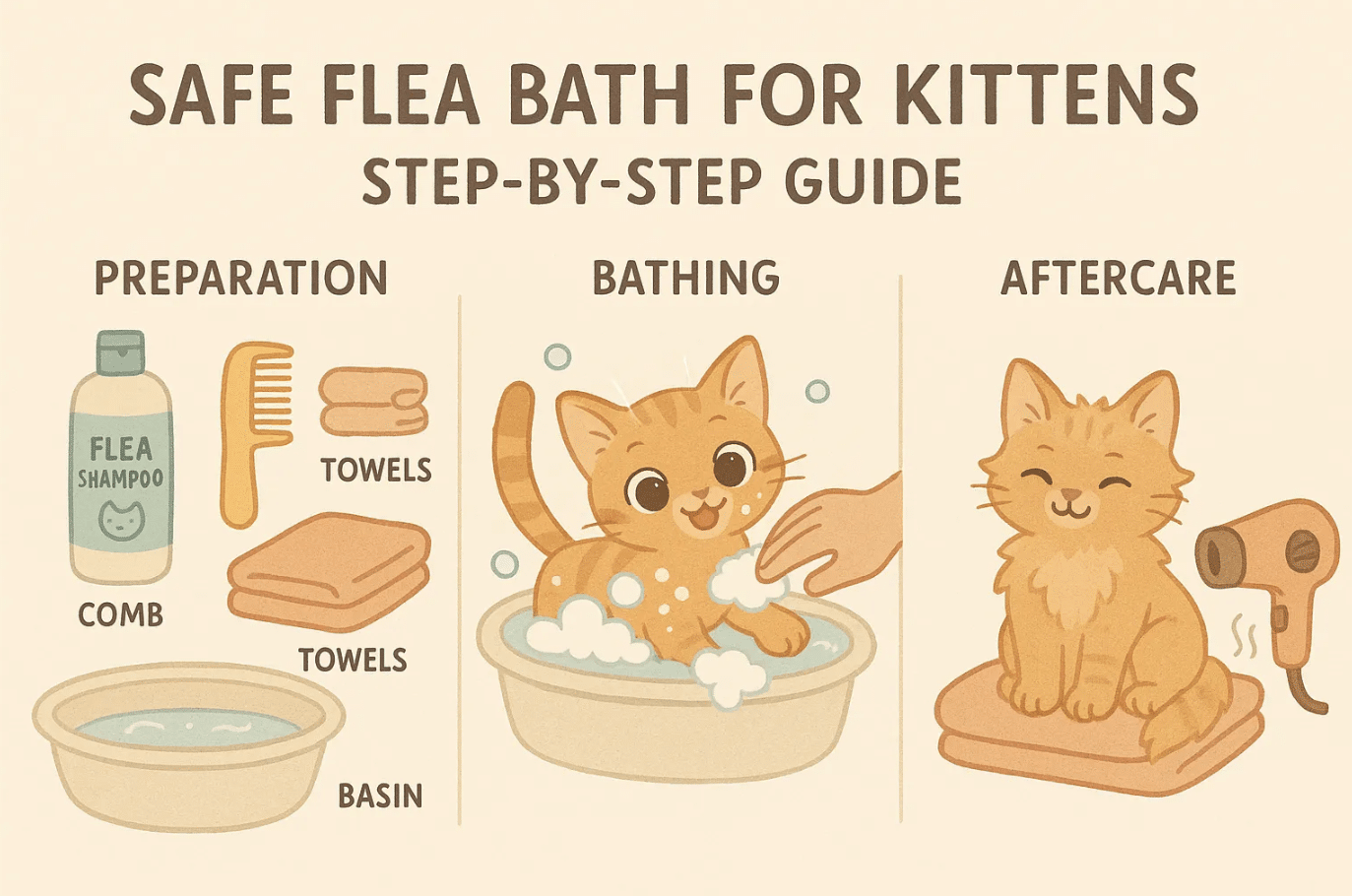
Fleas can be a nightmare for kittens, especially for a 2 month old kitten whose tiny body is more vulnerable to these pesky parasites. These little pests don’t just cause itching—they can lead to serious health problems. Did you know fleas can transmit diseases like bartonellosis or even cause anemia in kittens? Anemia, often marked by pale gums and lethargy, can be life-threatening if untreated. That’s why learning how to give kitten a flea bath is so important.
A gentle flea bath not only removes fleas but also soothes your kitten’s irritated skin. Using kitten-safe methods ensures their delicate skin stays protected while effectively tackling the problem. Don’t worry—this process is easier than it sounds. With the right preparation and a calm approach, you’ll have your kitten flea-free and comfortable in no time.
Preparing for How to Give Kitten a Flea Bath
Getting ready for a flea bath for your cat is just as important as the bath itself. Proper preparation ensures the process goes smoothly and keeps your kitten calm and safe. Let’s break it down step by step.
Gather Essential Supplies
Before you start, make sure you have everything you need within arm’s reach. Trust me, you don’t want to be scrambling for a towel while holding a wet, wiggly kitten!
Here’s what you’ll need:
-
Kitten-safe flea shampoo or Dawn dish soap: Choose a gentle, fragrance-free option to protect your kitten’s sensitive skin. Avoid medicated shampoos unless your vet recommends them.
-
A shallow basin or sink: This makes it easier to control the water level and keep your kitten secure.
-
Soft towels and a flea comb: You’ll need these to dry your kitten and remove any lingering fleas after the bath.
Using lukewarm water is key. It’s warm enough to keep your kitten comfortable but not too hot to irritate their skin. Also, remember to rinse thoroughly to avoid leaving any soap residue behind.
Create a Calm Environment
Kittens can sense when something’s up, so setting the right mood is crucial. I always pick a quiet, warm spot for the bath. A draft-free bathroom works great. Lay out all your supplies beforehand to avoid unnecessary movement that might startle your kitten.
Place a non-slip mat in the sink or basin to make the space kitten-friendly. This prevents slipping and helps your kitten feel more secure. If your kitten is new to baths, let them explore the area a bit before adding water. This helps them get comfortable with the surroundings. Timing matters too. I’ve found that giving your cat a flea bath after a play session works wonders. They’re usually more relaxed and less likely to resist.
Calm Your Kitten Before Bathing
A calm kitten makes the whole process easier for both of you. Start by handling your kitten gently and speaking in soothing tones. If they’re nervous, offer a favorite treat or toy to distract them.
You can also acclimate your kitten to water gradually. Use a damp washcloth to gently wipe their fur a few days before the bath. This helps them get used to the sensation of being wet. Avoid loud noises or sudden movements during this time, as these can make your kitten anxious. Building trust is essential. Spend time with your kitten daily, letting them sniff and lick your hands. This creates a bond and helps them feel safe when it’s time for the bath.
Step-by-Step Guide to Bathing a Kitten
Prepare the Bath
Getting the bath ready is the first step to making this process smooth for you and your kitten. I always start by filling a shallow basin or sink with lukewarm water, about 4-5 inches deep. This depth is just enough to keep your kitten comfortable without overwhelming them.
Before placing your kitten in the water, test the temperature with your wrist or elbow. It should feel warm but not hot—think of the temperature you’d use for a baby’s bath.
A calm and steady approach works best here. I like to talk to my kitten softly while preparing the bath. This helps them feel at ease and reassures them that everything is okay. Once the water is ready, you’re all set to move on to the next step.
Lather with Kitten-Safe Shampoo
Shampooing your kitten is where the magic happens. Start by gently wetting their fur, beginning with their feet. This gradual approach prevents any sudden surprises that might scare them. Once their fur is damp, apply a small amount of kitten-safe shampoo or Dawn dish soap to their back.
Here’s how I do it step by step:
-
Pat your kitten gently all over to get them used to your touch.
-
Wet their feet first, then slowly work up to the rest of their body.
-
Apply the shampoo to their back and lather gently, avoiding sensitive areas like the face and ears.
-
Praise your kitten throughout the process to keep them calm and cooperative.
Focus on flea-prone areas like the neck, belly, and base of the tail. These spots are where fleas love to hide. Remember, a little shampoo goes a long way, so don’t overdo it. Once you’ve lathered thoroughly, it’s time to rinse.
Rinse and Remove Fleas
Rinsing is just as important as shampooing your kitten. I use a cup or a gentle spray to rinse off the shampoo, starting from the top and working my way down.
Rinse thoroughly to remove all soap residue, as leftover shampoo can irritate your kitten’s skin.
After rinsing, grab a flea comb and comb through their fur while it’s still damp. This helps remove any remaining fleas or eggs. Dip the comb into a bowl of soapy water after each pass to trap and kill the fleas. If you notice any stubborn fleas, repeat the combing process until your kitten is completely flea-free.
Taking your time during this step ensures your kitten feels comfortable and cared for. Once you’re done, you’re ready to move on to drying and post-bath care.
Handle Lingering Fleas
Even after thoroughly rinse and combing, you might notice she still has fleas clinging to her fur. Don’t worry—this is normal, especially during the first flea bath for your cat.
Let’s tackle those stubborn pests step by step.
Dispose of Fleas in Soapy Water
Once you’ve combed through your kitten’s fur, you’ll likely see fleas stuck in the comb’s teeth. These little critters can jump back onto your kitten if not handled properly. I always keep a bowl of soapy water nearby during the bath. After each pass with the flea comb, I dip it into the soapy water to trap and kill the fleas.
The soap breaks the surface tension of the water, ensuring the fleas can’t escape. It’s a simple but effective trick that works every time.
Here’s a quick tip: Use a white or light-colored bowl for the soapy water. This makes it easier to spot the fleas and confirm they’re no longer a threat. Trust me, seeing those fleas floating in the water is oddly satisfying!
Repeat Combing if You Noticed She Still Has Some Fleas
If you noticed she still has some fleas after the initial combing, don’t panic. It’s common for a few to hide in hard-to-reach spots. I recommend giving your cat a flea bath another quick comb-through, focusing on areas like the neck, under the legs, and the base of the tail. These are flea hotspots that often need extra attention. Take your time during this step.
Gently part the fur with your fingers to expose the skin, then run the comb through in small sections. If you find more fleas, dip the comb into the soapy water again.
Repeat this process until you’re confident your kitten is flea-free. Patience is key here, and your kitten will thank you for it later.
Once you’ve finished, give your kitten a warm cuddle to reassure them. They’ve been through a lot, and a little extra love goes a long way in helping them feel safe and secure.
Post-Bath Care After a Flea Bath
Dry and Warm Your Kitten
Drying your kitten properly is equally important after you’ve given her a bath. I always start by wrapping her snugly in a soft, absorbent towel. Gently pat her fur to remove as much water as possible.
Avoid rubbing, as this can irritate her delicate skin. If she’s still damp after the first towel, switch to a fresh one and repeat the process.
Keeping her warm is just as important. I like to place her in a cozy, draft-free room while she dries completely. If you’re worried about her getting cold, you can use a low-heat blow dryer.
Just keep it at a safe distance and watch for any signs of discomfort. Some kittens might find the noise scary, so be patient and reassuring.
Here’s a quick checklist for drying and warming:
-
Use a warm, absorbent towel to blot her fur.
-
Keep her in a warm, draft-free area.
-
Consider a low-heat blow dryer if she tolerates it.
-
Supervise her closely to ensure she stays comfortable.
Inspect for Remaining Fleas
Once she’s dry, it’s time to check for any lingering fleas. I grab my trusty flea comb and carefully go through her fur again. Pay close attention to flea-prone areas like her neck, belly, and tail base. If you spot any fleas, dip the comb into soapy water to trap and kill them.
Sometimes, a second round of combing is necessary.
Don’t rush this step—it’s better to be thorough now than to deal with another infestation later. If you notice she still has fleas after combing, you might need to repeat the bath process in a day or two.
Monitor Your Kitten’s Comfort
After all that effort, your kitten deserves some extra TLC. I always make sure she’s relaxed and comfortable post-bath. Offer her gentle cuddles and speak softly to reassure her. A favorite toy or treat can help lift her spirits if she seems stressed.
Keep an eye on her behavior for the next few hours. If she’s shivering or seems uncomfortable, double-check that she’s completely dry and warm. A 2 month old kitten is especially sensitive to temperature changes, so it’s important to keep her cozy. Taking these steps not only ensures her comfort but also strengthens the bond between you two. She’ll feel safe and loved, which makes future baths much easier.
Additional Tips to Prevent Fleas
Getting rid of fleas is only half the battle. To stop seeing fleas for good, you’ll need to take a few extra steps. Here are some tips to help prevent a flea problem from coming back.
Avoid Harmful Products
Regarding flea treatment, not all products are safe for kittens. I’ve learned that using treatments meant for adult cats or dogs can be dangerous. Here’s why:
-
Kittens can’t process certain chemicals as well as adult cats, making them more prone to toxicity.
-
Permethrin, a common ingredient in flea medications, is highly toxic to cats—even in small amounts.
-
Essential oils, often marketed as natural remedies, can also harm kittens and should be avoided.
Always consult your vet before trying any flea treatment. They can recommend safe options tailored to your kitten’s age and weight. Trust me, it’s better to be cautious than to risk your kitten’s health.
Clean Your Home Thoroughly
A clean home is key to preventing a flea infestation. Fleas don’t just live on your kitten—they hide in your home too. Here’s what I do to keep my space flea-free:
-
Wash all bedding, including your kitten’s, in the warmest water possible. This kills fleas and their eggs.
-
Vacuum carpets, floors, and furniture regularly. Pay special attention to cracks and crevices where fleas might hide.
-
Consider using pet-safe flea sprays or home remedies like Borax for extra protection.
-
If you have other pets, treat them as well. Fleas can easily jump from one animal to another.
Professional pest control might be necessary for severe infestations. It’s an investment, but it can save you a lot of trouble in the long run.
Consult a Veterinarian
If you’ve done everything and still can’t get rid of fleas, it’s time to consult a vet. Persistent flea problems might require a more targeted approach. Your vet can help you:
-
Identify the root cause of the infestation.
-
Discuss long-term strategies, like using a monthly flea preventative once your kitten is old enough.
Regular vet check-ups are also a great way to stay ahead of flea issues. Prevention is always easier than dealing with an infestation later.
Taking these steps will help you stop seeing fleas and keep your kitten happy and healthy. A little effort now can save you a lot of stress down the road.
Common Concerns and Mistakes to Avoid When Giving a Flea Bath
Giving your kitten a flea bath can be tricky, especially the first time. You might face challenges, but don’t worry! With patience and preparation, you can make it easier for both of you. Let’s look at some common concerns and mistakes to avoid.
Potential Challenges
Kitten’s Fear of Water
Many kittens are scared of water. This fear makes bath time stressful. To help them feel better, introduce water slowly. Let them play with a shallow dish of water first. This helps them get used to it. Speak softly and reassure them during the bath. Your calmness helps ease their fear.
Difficulty in Handling
Handling a wiggly kitten during a bath is hard. They might try to escape or scratch you. Hold your kitten gently but firmly. Use one hand to support their body and the other to wash them. If it’s tough, ask someone for help. Another person can make the process smoother.
Common Mistakes
Using Human Shampoo
A big mistake is using human shampoo on kittens. It has chemicals that irritate their skin. Always use shampoo made for kittens only. These are gentle and fight fleas well. Keeping their skin healthy is as important as removing fleas.
Not Rinsing Thoroughly
Not rinsing well is another mistake people make. Leftover shampoo causes skin irritation and discomfort. Rinse your kitten’s fur completely with lukewarm water, taking your time to do so thoroughly.
Once you understand these challenges, you can give your kitten an effective flea bath without stress. Each bath gets easier as you both adjust to the routine. Your efforts will lead to a happy, flea-free kitten ready for fun days.
Removing fleas from a kitten might initially seem overwhelming, but it’s all about using a gentle, kitten-safe approach. Preparation makes a huge difference. Having the right supplies and creating a calm environment ensures the process goes smoothly. Post-bath care, like drying and inspecting for lingering fleas, keeps your kitten comfortable and healthy.
If you’re ever unsure or the flea problem persists, don’t hesitate to reach out to your vet. They can guide you with safe and effective solutions. Remember, a little patience and care go a long way in keeping your kitten happy and flea-free! 🐾

In her previous life, Lisa traveled extensively, both for work and leisure. After the pandemic struck, Lisa locked up her luggage and adopted a cat ever since.
Lisa is now an avid cat lover, she devotes most of her free time serving as butler to her adorable feline at home. When she is not with her cat, she can be seen using her phone sourcing for the latest cat supplies online.


